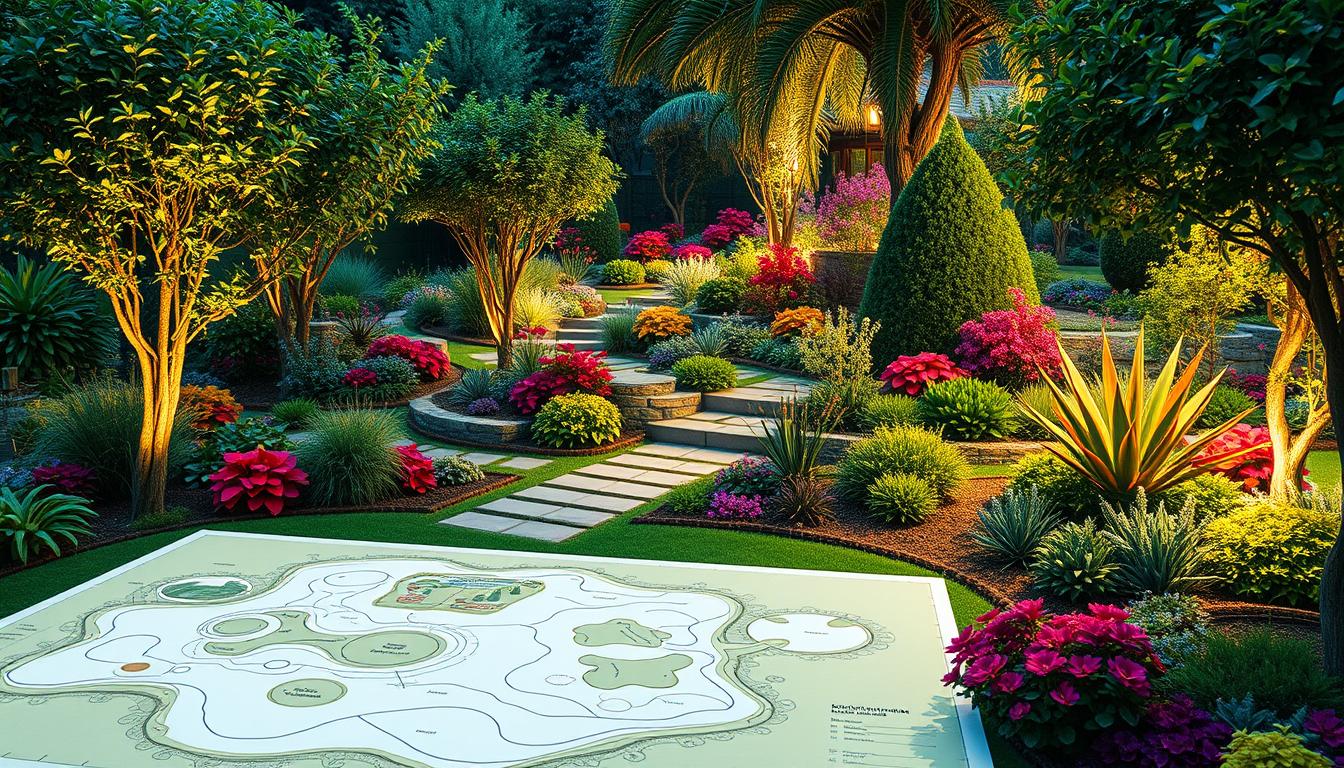Transforming your outdoor area into a stunning retreat starts with a thoughtful approach. A tailored garden design plan acts as a blueprint, ensuring every detail aligns with your vision. Whether you have a small patio or a sprawling yard, personalized planning maximizes space efficiency and brings your ideas to life.
This process combines aesthetics, functionality, and the health of your plants. By focusing on these elements, you can create a landscape that not only looks beautiful but also thrives over time. Resources like Monrovia’s curated guides offer inspiration for crafting spaces that delight for decades.
Structured planning ensures long-term success, avoiding the pitfalls of haphazard planting. With a clear plan, you can enjoy a space that evolves with your needs and enhances your lifestyle.
Key Takeaways
- Tailored plans act as blueprints for outdoor transformation.
- Personalized designs maximize space efficiency.
- A holistic approach combines aesthetics, functionality, and plant health.
- Structured planning ensures long-term benefits.
- Resources like Monrovia’s guides provide inspiration.
Introduction to Garden Design Plans
Crafting a beautiful outdoor space begins with a clear vision. A garden design plan is a strategic layout that balances aesthetics with the needs of your plants. It ensures every element, from plant placement to pathways, works harmoniously to create a cohesive look.
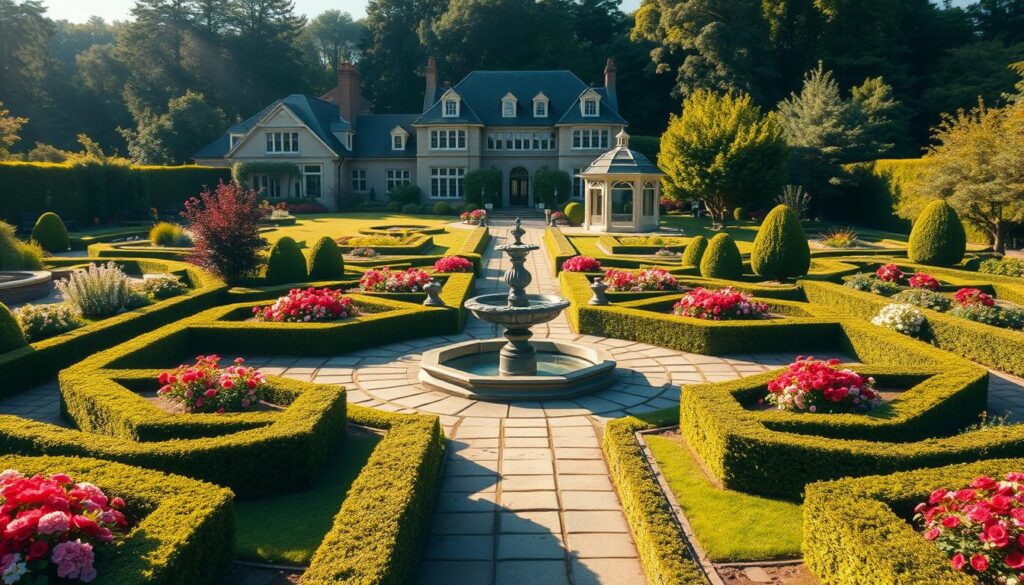
What is a Garden Design Plan?
This type of plan is more than just a sketch. It’s a detailed guide that considers factors like microclimates, soil types, and your personal preferences. For example, Monrovia’s Front Yard Design guide uses a “foolproof formula” to create adaptable layouts that suit any space.
Why You Need a Personalized Plan
A personalized approach ensures your outdoor area reflects your unique style. It also accounts for seasonal changes and long-term growth, making your space functional and beautiful year-round. Trellises, like those from Gardenary, add vertical interest while maximizing space.
For inspiration, check out Monrovia’s 2024 “Shades of Beautiful” guidebook. It offers 10 color palettes for cohesive plant combinations. If you’re just starting, this beginner’s guide can help you take the first steps.
Assessing Your Outdoor Space
To make the most of your yard, start by assessing its unique features and layout. This step ensures every inch of your outdoor area is utilized effectively. Begin by sketching existing elements like trees, slopes, or structures using grid paper or apps. This helps you visualize the space and plan accordingly.
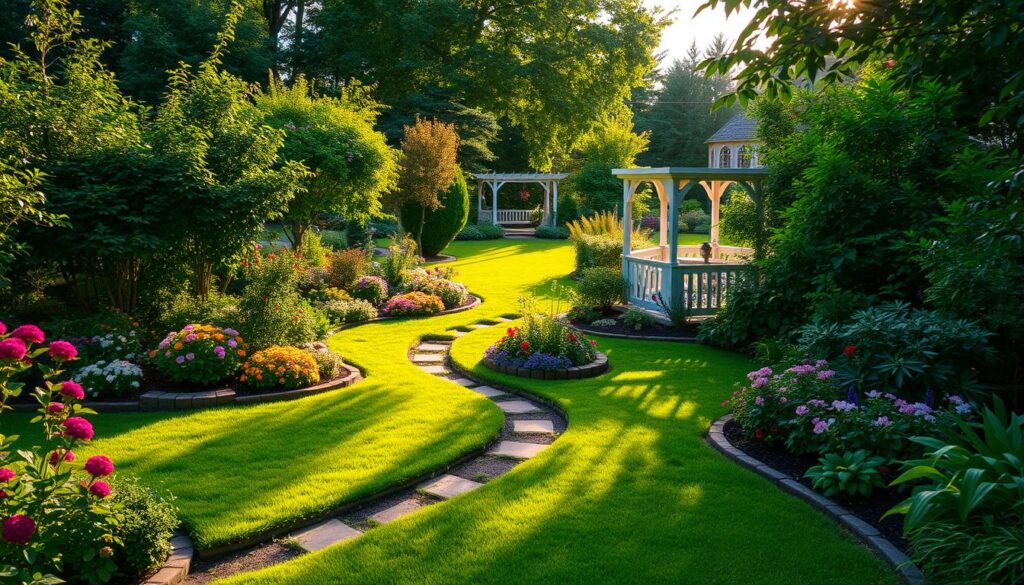
Tracking sunlight patterns is crucial for determining where to place your plants. Observe how light moves across your ground throughout the day. Additionally, test your soil to understand its composition and pH levels. This information guides your plant selection and ensures healthy growth.
For poor soil conditions, consider using raised beds. Monrovia’s “Weekend Projects” guide offers quick solutions for creating these structures. They not only improve soil quality but also add visual interest to your area.
If you have a narrow urban yard, vertical structures like trellises can maximize space. Containers are another great option for defining zones in irregularly shaped areas. These strategies help you create a functional and aesthetically pleasing outdoor environment.
Choosing the Right Plants for Your Garden
Selecting the right plants is the cornerstone of a thriving outdoor space. The success of your landscape depends on choosing varieties that suit your local climate and soil conditions. This ensures healthy growth and reduces maintenance over time.
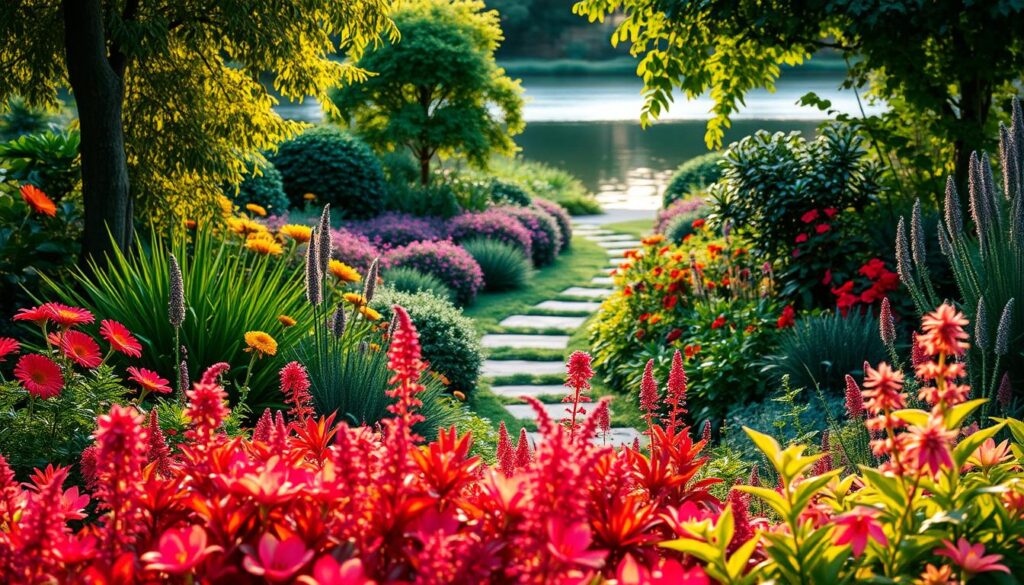
Selecting Plants Based on Climate
Understanding USDA hardiness zones is essential for plant survival. These zones indicate the average minimum winter temperatures in different regions. For example, Monrovia’s Distinctive Selections guide highlights disease-resistant plants like ‘Summer Crush’ hydrangeas, which thrive in specific zones.
Native species are another excellent choice. They adapt well to local conditions and support local ecosystems. Plus, they often require less water and care compared to non-native varieties.
Incorporating a Variety of Flowers, Shrubs, and Trees
Diversity in your landscape adds visual interest and supports biodiversity. Consider layering plants by height. Understory trees like Japanese maples can provide shade for smaller shrubs and flowers.
Monrovia’s “Shades of Beautiful” palettes offer inspiration for harmonious color schemes. These combinations ensure your space looks cohesive throughout the season.
Be cautious of invasive species like English ivy in temperate regions. These can quickly overtake your landscape and harm native plants.
| Native Species | Invasive Species |
|---|---|
| Black-eyed Susan | English Ivy |
| Eastern Redbud | Japanese Honeysuckle |
| Switchgrass | Kudzu |
By carefully selecting plants, you can create a vibrant and sustainable outdoor space. Focus on native species, consider your climate, and avoid invasive varieties for the best results.
Designing Your Garden Layout
A well-organized outdoor space starts with a thoughtful layout. This step ensures every area serves a purpose, from growing plants to relaxing with friends. By dividing your space into functional zones, you can create a seamless flow that enhances usability and beauty.
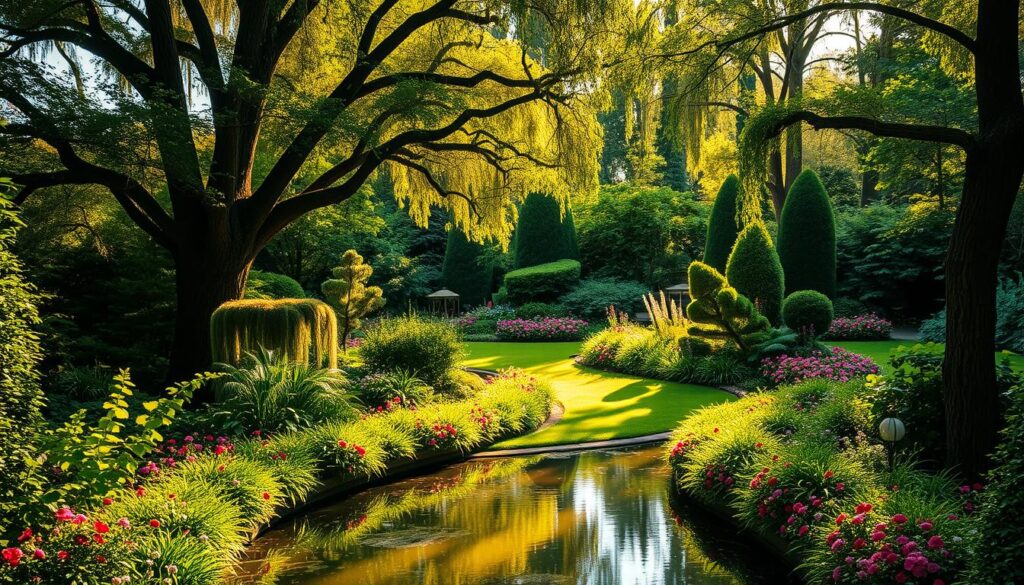
Creating Zones for Different Plants
Divide your area into sections based on their purpose. For example, dedicate one zone for entertaining, another for growing vegetables, and a third for relaxation. Use curved beds instead of straight lines to create a naturalistic feel. This approach adds visual interest and makes the space feel more organic.
Consider using containers for flexibility. They allow you to move plants as needed and define specific areas. Monrovia’s whiskey barrel water garden is a great example of a compact focal point that adds charm to any space.
Planning for Pathways and Seating Areas
Pathways are essential for connecting different zones. Use materials like gravel or stepping stones for a permeable, low-maintenance option. These materials also add texture and contrast to your layout.
Integrate seating nooks into your plan. Surround them with fragrant plants like lavender for sensory appeal. This creates inviting spots to relax and enjoy your outdoor area. Monrovia’s “Outdoor Living Guide” offers excellent ideas for transitioning from a patio to a lush, green space.
- Divide spaces into functional zones (e.g., entertaining, growing, relaxation).
- Use gravel or stepping stones for permeable, low-maintenance pathways.
- Integrate seating nooks with fragrant plants for sensory appeal.
- Opt for curved beds over rigid lines for a naturalistic flow.
- Use containers for flexibility and defining areas.
Incorporating Garden Structures
Enhancing your outdoor space with thoughtful structures can elevate both functionality and beauty. These elements not only add visual interest but also maximize space and support healthy plant growth. From trellises to raised beds, each structure serves a unique purpose in creating a cohesive and thriving environment.
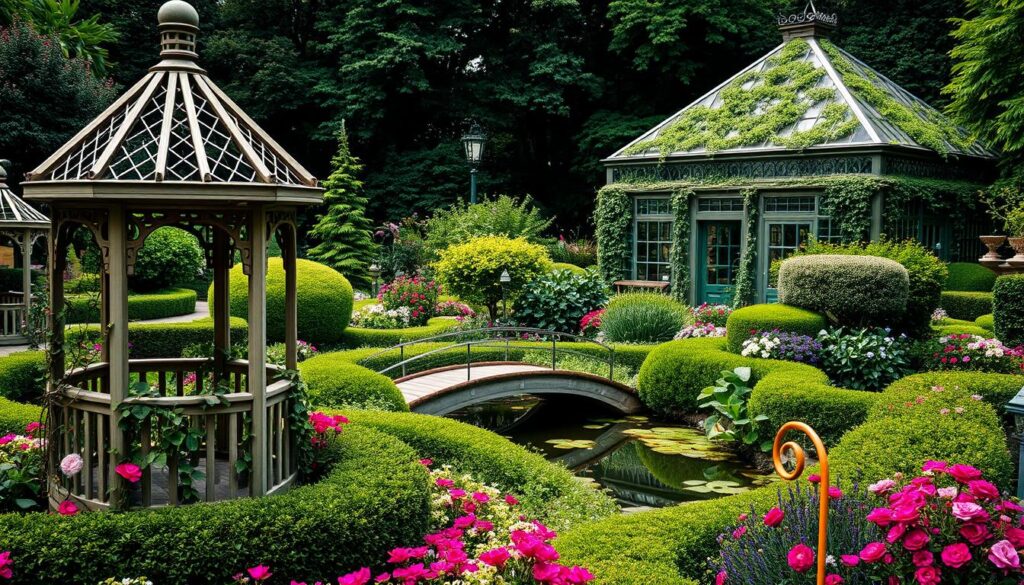
Using Trellises for Vertical Growth
Trellises are a fantastic way to encourage vertical growth for vining plants like cucumbers and melons. Gardenary highlights how these structures improve air circulation and increase yield. Cattle panel trellises, for instance, are sturdy enough to support heavy crops like melons, ensuring they grow upward instead of sprawling on the ground.
Repurposing items like old ladders can also add a quirky touch to your space. These DIY solutions not only save money but also bring a unique charm to your outdoor area.
Adding Raised Beds and Containers
Raised beds and containers are excellent for improving soil quality and defining specific areas. Cedar beds are popular for their natural look and durability, while metal beds offer a modern aesthetic and longevity. Both options provide excellent drainage and prevent soil compaction.
Monrovia’s container designs, such as the thriller-filler-spiller arrangement, are perfect for patios. This technique combines tall, mid-height, and trailing plants to create a balanced and visually appealing display. Avoid overcrowding to maintain plant health and ensure each one has enough space to thrive.
| Material | Durability | Aesthetics |
|---|---|---|
| Cedar | High | Natural, rustic |
| Metal | Very High | Modern, sleek |
By incorporating these structures, you can create a functional and beautiful outdoor space that supports your plants and enhances your lifestyle.
Choosing a Color Palette for Your Garden
Color plays a vital role in shaping the feel of your outdoor area. The right hues can create a sense of harmony, enhance beauty, and add visual appeal. Whether you prefer bold contrasts or soft blends, a thoughtful approach to color selection ensures your space looks stunning year-round.

Selecting Colors That Complement Your Space
Understanding the color wheel is key to creating a cohesive look. Analogous schemes use colors next to each other on the wheel, like blue and green, for a calming effect. Complementary schemes, such as purple and yellow, create striking contrasts that draw the eye.
Evergreen shrubs make excellent backdrops for seasonal blooms. Their neutral tones allow colorful flowers to stand out. Monrovia’s 2024 “Shades of Beautiful” guide offers inspiring combinations, like coral bells paired with blue fescue, for a balanced and vibrant look.
Seasonal Color Considerations
Your color palette should evolve with the seasons. In spring, pastel shades like pink and lavender bring a fresh, lively feel. Summer calls for bold hues like red and orange to match the energy of the season.
Transitional plants, such as sedum, add interest in autumn with their rich, warm tones. White flowers, like phlox, brighten shady corners and provide a timeless elegance. Avoid overusing reds in small spaces, as they can create visual clutter.
| Color Scheme | Example | Effect |
|---|---|---|
| Analogous | Blue, Green, Teal | Calming and harmonious |
| Complementary | Purple, Yellow | Bold and eye-catching |
By carefully selecting colors and considering seasonal changes, you can create an outdoor space that is both beautiful and functional. Let your creativity guide you, and don’t be afraid to experiment with different combinations.
Creating a Kitchen Garden
Growing your own fresh produce can be both rewarding and practical. A kitchen garden allows you to enjoy homegrown flavors while adding beauty to your space. Whether you have a small balcony or a dedicated plot, careful planning ensures a productive and attractive setup.

Selecting Herbs and Vegetables
Start by choosing high-yield crops like cherry tomatoes and basil for small spaces. These are easy to grow and provide a steady harvest. Perennial herbs like rosemary and thyme make excellent low-maintenance borders, adding both flavor and greenery.
Interplanting marigolds can naturally deter pests, reducing the need for chemicals. Jon Carloftis’ Ultimate Kitchen Garden Plan suggests integrating edible flowers like nasturtiums for both beauty and utility. This approach creates a balanced and thriving ecosystem.
Designing a Functional and Aesthetic Layout
Your layout should combine practicality with visual appeal. Use geometric patterns in raised beds to create order and symmetry. This not only looks neat but also makes maintenance easier.
Consider using containers for flexibility. They allow you to move plants as needed and define specific areas. Monrovia’s “Weekend Project Guide” offers quick setups like herb spirals, which are both functional and decorative.
- Prioritize high-yield crops for small spaces.
- Use marigolds to naturally deter pests.
- Opt for geometric patterns in raised beds.
- Incorporate containers for flexibility.
- Add perennial herbs for low-maintenance borders.
With thoughtful planning, your kitchen garden can become a source of fresh produce and a beautiful addition to your home.
Designing a Pollinator-Friendly Garden
Supporting local ecosystems while adding beauty to your space is easier than you think. By choosing the right plants and creating a welcoming habitat, you can attract bees, butterflies, and other essential pollinators. This not only enhances your outdoor area but also contributes to the health of the environment.

Choosing Plants That Attract Bees and Butterflies
Selecting the right flowers is key to attracting pollinators. Native species like milkweed, coneflower, and salvia are excellent choices. These plants provide nectar and pollen, which are essential for the survival of bees and butterflies.
Staggering bloom times ensures a continuous food source. Early bloomers like crocus and late bloomers like asters keep pollinators fed throughout the season. Monrovia’s “bee and butterfly garden” design, which includes 90% native species, is a great resource for inspiration.
Creating a Habitat for Pollinators
Beyond plants, pollinators need a safe and supportive environment. Shallow water dishes with stones provide hydration for insects. Avoid using pesticides, as they can harm beneficial creatures. Instead, try companion planting to naturally deter pests.
Monrovia’s Backyard Habitat Guide offers plans for hummingbird-friendly sections, adding another layer of biodiversity. By incorporating these elements, you can create a thriving habitat that supports pollinators year-round.
Incorporating Water Features
Incorporating water elements brings a calming vibe to any area. Whether it’s a small pond or a compact water garden, these features add both beauty and functionality to your space. They create a focal point while enhancing the overall ambiance.
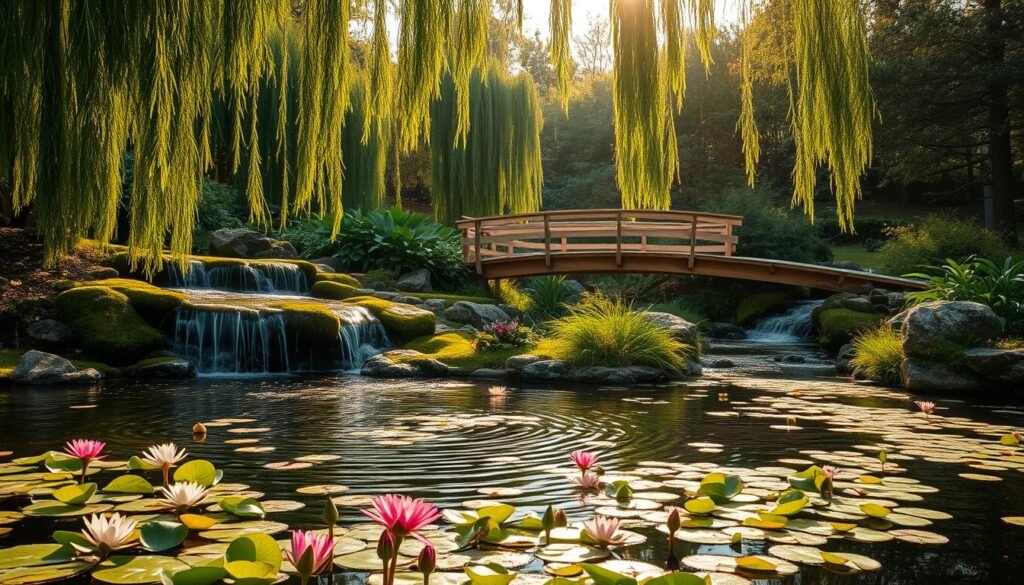
Adding a Small Pond or Water Garden
For urban spaces, Monrovia’s whiskey barrel water garden is a perfect fit. It’s compact, easy to maintain, and suits small patio areas. Use recirculating pumps to keep the water moving, which reduces mosquito risks and keeps the feature clean.
Edge your pond with water-loving plants like pickerelweed. These plants not only add natural charm but also help filter the water. Avoid invasive species like water hyacinths, which can quickly take over and disrupt the ecosystem.
Using Water Features for Aesthetic Appeal
Enhance the visual appeal of your water feature with floating LED lights. These create a magical glow in the evening, adding to the aesthetic appeal of your space. Position the feature near seating areas to enjoy the soothing soundscapes it creates.
For a modern touch, consider using containers to house smaller water elements. This approach is versatile and allows you to move the feature as needed. It’s a great way to add interest without committing to a permanent structure.
- Use recirculating pumps to reduce mosquito risks.
- Add water-loving plants like pickerelweed for natural filtration.
- Incorporate floating LED lights for evening ambiance.
- Position features near seating areas for soothing soundscapes.
- Avoid invasive species like water hyacinths.
Planning for Seasonal Changes
Adapting your outdoor space to the changing seasons ensures it remains vibrant all year. By selecting the right plants and preparing for colder months, you can enjoy a beautiful and functional area regardless of the weather. A little foresight goes a long way in maintaining its appeal.

Selecting Plants for Year-Round Interest
To keep your space lively throughout the year, choose varieties that offer visual interest in every season. Evergreen grasses, like blue fescue, add texture even in winter. Monrovia’s “Distinctive Selections” highlights winter-blooming hellebores, which bring color when most plants are dormant.
Ornamental kale is another excellent choice for cold-weather color. Its vibrant hues stand out against the ground, creating a striking contrast. Pair these with evergreen shrubs for a balanced look that lasts all year.
Preparing Your Garden for Winter
Proper preparation ensures your outdoor area survives the colder months. Mulching protects perennial roots from frost, while draining irrigation systems prevents freeze damage. Monrovia’s bark-appeal garden plan offers structural interest even when plants are not in bloom.
Here are some quick tips to get started:
- Use evergreen grasses for winter texture.
- Apply mulch to protect perennial roots.
- Add ornamental kale for cold-weather color.
- Drain irrigation systems to prevent freeze damage.
- Reference Monrovia’s bark-appeal plan for structural interest.
With these strategies, your outdoor space will thrive through every season, offering beauty and functionality year-round.
Maintaining Your Garden Design Plan
Keeping your outdoor space thriving requires consistent care and attention. Regular maintenance ensures your area remains healthy, beautiful, and functional. By dedicating time to essential tasks, you can enjoy a vibrant space for years to come.

Regular Pruning and Weeding
Pruning is a key part of maintenance. Use the “three-cut method” for large branches to prevent damage. This technique ensures clean cuts and promotes healthy growth. Monrovia’s “Weekend Project Guide” offers quick tips for efficient pruning.
Weeding is equally important. Installing weed barrier fabric under gravel paths reduces unwanted growth. This simple step saves time and keeps your space tidy. Regularly removing weeds also prevents them from competing with your plants for nutrients.
Adjusting Your Plan as Your Garden Grows
Your outdoor area evolves over time. Conduct annual reviews of your plan to identify underperforming plants. Replace them with varieties that better suit your space and climate. This ensures your area remains vibrant and functional.
Tracking growth patterns is helpful. Use journaling or apps to monitor changes and make informed decisions. Gardenary’s trellis maintenance tips, for example, can extend the longevity of vining plants. By staying proactive, you can adapt your space to meet your needs.
- Use the “three-cut method” for clean and effective pruning.
- Install weed barrier fabric to minimize unwanted growth.
- Review your plan annually to remove underperforming plants.
- Track growth patterns with journaling or apps.
- Follow Gardenary’s tips for trellis maintenance.
Budgeting for Your Garden Design
Creating a stunning outdoor space doesn’t have to break the bank. With careful planning and smart choices, you can achieve a beautiful area without overspending. Start by estimating costs for plants and materials, then explore cost-effective solutions to stay within your budget.
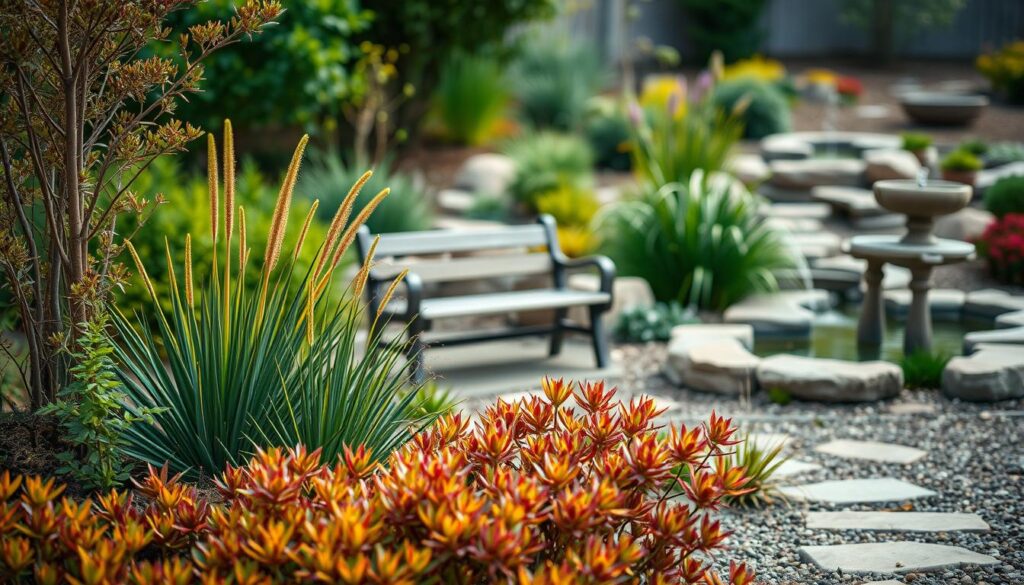
Estimating Costs for Plants and Materials
Understanding expenses is the first step in managing your budget. Compare prices for bulk soil versus bagged options, especially for larger projects. This can save you money while ensuring quality. Monrovia’s “Distinctive Selections” guide highlights high-impact perennials that offer long-term value, reducing the need for frequent replacements.
Here’s a quick comparison of common materials and their costs:
| Material | Cost | Best Use |
|---|---|---|
| Bulk Soil | $30 per cubic yard | Large planting areas |
| Bagged Soil | $5 per bag | Small projects or containers |
| Cinder Blocks | $1 per block | Raised beds or borders |
Finding Cost-Effective Solutions
There are many ways to save without compromising quality. Consider seed swaps with local clubs to diversify your plants at no extra cost. Slow-growing shrubs are another smart choice, as they require less maintenance and fewer replacements over time.
Monrovia’s “Cost-Effective Container Gardens” guide suggests repurposing items like cinder blocks for raised beds. This not only saves money but also adds a unique touch to your space. Phased installations are another great strategy, allowing you to spread expenses over multiple seasons.
- Compare bulk vs. bagged soil for large projects.
- Join seed swaps to expand your plant variety.
- Choose slow-growing shrubs to minimize replacement costs.
- Use Monrovia’s guides for high-impact, budget-friendly ideas.
- Install features in phases to manage expenses.
By following these tips, you can create a beautiful outdoor area that fits your budget and meets your needs. Smart planning and creative solutions make it possible to enjoy a stunning space without overspending.
Conclusion
A personalized approach can turn any outdoor area into a harmonious retreat. By creating a custom plan, you can transform chaotic spaces into cohesive and functional environments. Start small with Monrovia’s “Weekend Project” templates to make the process manageable and enjoyable.
Your outdoor space will evolve over time, reflecting your unique style and preferences. This journey of growth and creativity brings joy and satisfaction. Share your progress with others using #MyMonroviaGarden to inspire and connect with fellow enthusiasts.
There’s no better time to begin. With a thoughtful design, you can create a space you’ll enjoy for years to come. Take the first step today and watch your vision come to life.

